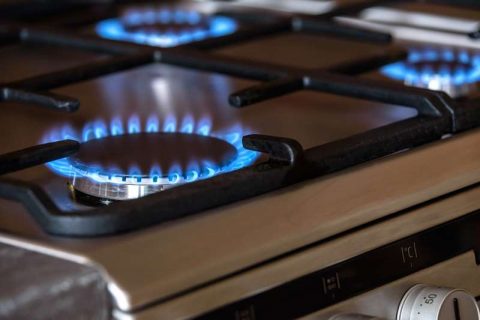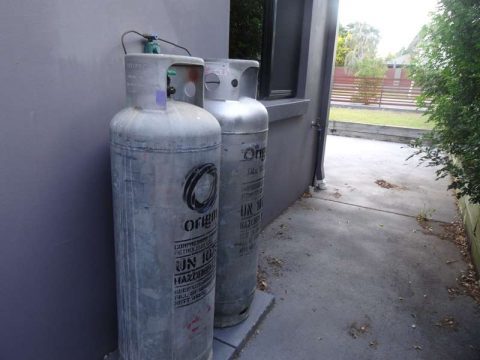As you know, we recently moved to a new house. Our previous house was all electric, which wasn’t such a bad thing, especially after we fitted our solar panels. One drawback though was our cooker, it was electric.
Mrs Bob would tell me whilst it looked like a normal cooker, it had one major difference. The knobs which controlled the heat intensity on the cooking rings went from 1 to 6. According to Mrs Bob though, the problem was number 1 was really no different to number 6, making the art of ‘simmering’, whatever that is, impossible.
Now though, Mrs Bob is cooking on gas…
 And she absolutely loves it. She tells me she now feels she has full control, which I had never doubted for one minute.
And she absolutely loves it. She tells me she now feels she has full control, which I had never doubted for one minute.
LPG versus natural gas
Our cooker, which is the only gas appliance in the house, runs on LPG, which is liquid petroleum gas. Where we live, which is about 20 kilometres from Brisbane CBD, we do not have piped natural gas available to us.
It is available in selected areas in and around Brisbane though. Natural gas appears to be quite popular in Victoria, especially around Melbourne, and also in South Australia. As much as I tried though, I couldn’t get any firm information about the percentages of households across Australia who can access piped natural gas.
For those who cannot get access though, like ourselves here, there is LPG, which is delivered to your home in 45 kg cylinders like this…

 LPG is a completely different product from natural gas. LPG is a mix of butane and propane whereas natural gas is a mixture of methane and ethane. I would like to thank my chemistry lessons back in 1973 for that information, but of course, I can’t; I didn’t have a clue. I was probably staring out of the window when that particular piece of information was imparted, but thankfully Dr Chemical was able to enlighten me.
LPG is a completely different product from natural gas. LPG is a mix of butane and propane whereas natural gas is a mixture of methane and ethane. I would like to thank my chemistry lessons back in 1973 for that information, but of course, I can’t; I didn’t have a clue. I was probably staring out of the window when that particular piece of information was imparted, but thankfully Dr Chemical was able to enlighten me.
Butane and propane can be compressed into a liquid, hence liquid petroleum gas (LPG), making it ideal for home deliveries in cylinders. Mrs Bob, I can tell you, is very happy about that.
Buying LPG
As soon as we moved into our new house, I noticed that our LPG gas cylinders appeared to be pretty much empty. The gas cooker was working, but it seemed to me that it could run out at any moment. Being new to the gas market, I had no idea how it worked or who to buy from.
So I went online.
Turns out I had a selection of companies I could get LPG from in my area and I decided to get three quotes; Origin Energy, Elgas and Plusgas. But did any of these companies post their prices online for all to see?
Of course not! Even though it would be incredibly simple to do it, to find out the cost of these cylinders I needed to telephone each company separately and talk to their helpful sales staff.
First up was Origin Energy and they quoted me $123 for a 45 kg cylinder. Additionally, I would need to pay an annual fee of $39.50 per cylinder for maintenance.
Next, I called Elgas who said the first eight cylinder refills I ordered would cost just $109 and thereafter they would charge me $119 per cylinder. They charged $40.50 per annum maintenance for each cylinder.
I then called Plusgas who quoted $110 per 45 kg and plus $30 annual maintenance per bottle, so that was probably the best quote of the lot.
All prices above included delivery and GST.
Finally, I decided to call Origin Energy back again to negotiate with them for a couple of reasons. Their website does state they will beat any competitors quote and I already had an account with them for my electricity, so it would have been more convenient to use them.
They couldn’t do anything about the $39.50 per bottle, but the salesperson said they would ‘speak to their manager‘ to see if he would authorise a really good price for me. I was then put on hold whilst I imagine that same salesperson stared at the ceiling for a couple minutes whilst I did the same from the comfort of my own home.
“We can give you a price of $103 per refill and guarantee that price for the next 12 months.” She then went on to advise me that I would need to renegotiate that deal in a years time.
Just shows you that, as I’ve said before, the art of haggling is still alive and well in Australia. Whether I have done the best deal available for our household, I really don’t know, that depends how many cylinders we get through each year.
Time will tell.
Of course, whether we have a gas cooker or an electric cooker doesn’t affect me in any way whatsoever. If I do find myself in a situation where I need to cook my own food, it’s the microwave for me. Piercing lids and waiting eight minutes is a particular speciality of mine.






HI bobin
We are moving to Oz in the later half of 2018.
Would like to know the houses/apartments are already fitted with the pipeline/valves/regulator and all for the standalone system you had ?
Thanks
Some are and some aren’t. For example, my last house wasn’t, my new house is. If LPG gas is not fitted, I’m pretty sure it can be set up without too much expense, maybe $500-$1000.